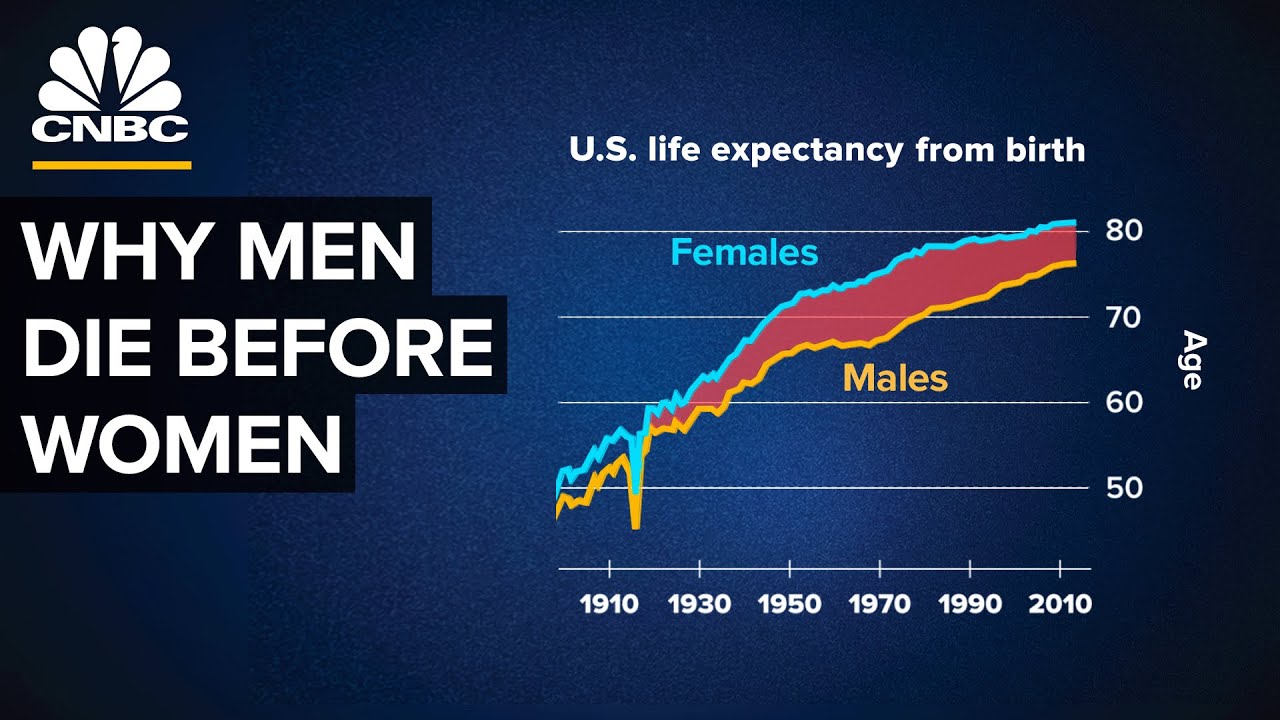Most men die before women do
in the United States In 2021, American women
lived, on average, 79 years. However, life expectancy
for American men was only About 73 years. This isn't just true of the
US. Women outlive men in 37
other comparable countries. As long as records have been
kept in an all countries, Women have lived longer
than men. Across basically almost
every major cause of death, Men are more likely to die
than women are. The United States has the
highest rate of avoidable Deaths among men or deaths
before the age of 75 than Any comparable country. For every 100,000 men in
the US, 337 die of avoidable Causes. That's over 100
more men than in the UK, the Country with the second
highest rate, and more than Double the number of Swiss
men who die prematurely. It's not that old women
outlive old men. It's that men tend to be
outlived by women in just About every age cohort. Demography really is
destiny. If you change the shape of
people, you change the shape Of everything. The US and countries around
the world are undergoing Rapid population aging. This can have serious
implications for society as A whole. Because women can expect to
live longer, but they've had Lower earnings. They've had patchier
careers. But they still have to
support a longer retirement Because they live longer. And so it's a particular
challenge for women. So why do men die before
women and what can we do
About it? So when you hear that the
life expectancy in 2021 was 76.1 years, it means that
on average people who died In that in 2021 died at the
age of 76 years. Well, the size of this life
expectancy gap between men And women differs across
places. Women always live longer,
and this is due to a Combination of biological,
social and behavioral Factors. There's some evidence that
biological differences Between men and women can
contribute to the life Expectancy gap. But biology
is not the only explanation. Understanding the role of
particular sex linked genes, Exposure to hormone
profiles that differ between Males and females, but also
differences in factors Related to health behaviors
such as smoking, engaging in Risky behaviors. I see this particularly at
younger ages. Men tend to be more likely
to die from things like Accidents, suggesting that
there are some behavioral Things, the sort of
stereotypical stories guys Ride in their motorcycles
around and that women are Less likely to do things
like that. And that's part of why they
live longer. Men are also less likely to
seek out mental health Treatment than women.
Suicide is one of the Leading causes of death
among men, and they are four Times more likely to die
due to suicide than women. That men are just socialized
to live riskier lives if They don't go to the
doctor. When they do go to The doctor, they don't
listen to the doctor's Advice. When they're
prescribed medication, they Don't finish their
medication. So there's a Whole area of men's health
that relates to things like
Watching, monitoring, doing
the things that women are More likely to do, which is
one of the reasons that they Live longer, that men have
not been socialized to do to The same extent. Data from the Bureau of
Labor Statistics finds that Men are more likely to die
due to work related Incidents, and this is
because men are more likely To work in the most
dangerous jobs in the Country. So industries like
logging, fishing and Hunting, construction and
mining. The numbers also get more
complicated when factoring In race. African-American men are
tremendously disadvantaged In terms of the likelihood
that they will live long, Healthy lives. But this is
due to social factors. So exposure to subpar
medical care, racial Discrimination in everyday
life, major episodes of Discrimination, exposure
and the stress that Causes. There's also a disparity in
mortality rates among Transgender people. People who are on the trans
feminine to non-binary Spectrum are at the
greatest risk of mortality Compared to non-trans men
and women. Experts suspect this gap is
a result of both biological And social factors, but
they say that more research Is needed to fully
understand the causes behind The disparity. You know, it's funny, when I
give public presentations on This and I say, you know,
men are much more likely to Die in a car accident, you
know, everything stupid that You can do, men are much
more likely than women to do It to kill themselves. And
people laugh, you know, and It's not a joke.
There hasn't always been a
life expectancy gap between Men and women. What became
known as "the female Advantage" emerged around
1890 and continued to grow Throughout the 20th
century, except for a Decline during the 1918 flu
pandemic. This change over time
suggests to researchers that There could be an
environmental component to Life expectancy. That means there are some
steps we can take to work Towards helping men live
longer. Everybody, men as well as
women, benefit from a suite Of particular behaviors. So, for example, a healthy
diet, getting physical Activity, not smoking, no
to moderate alcohol Consumption, maintaining
deep supportive social Relationships. These are
things that benefit Everybody, including men. What is it about the
socialization of men that Means that they're not
participating in the health Care system the way they
should be to extend their Lives? Public policy measures can
also be taken to improve Men's health. So, for example, in Russia,
the life expectancy gap Between men and women is
huge. One of the factors that was
isolated was the Exceptionally high use of
alcohol by Russian men. And there was actually a
policy change a few decades Ago where they eliminated
the sale of vodka before Lunch time and life
expectancy for men went up. That's suggests fairly
convincingly that there's Something about behaviors,
social behaviors, which are Also modifiable, which I
think provides a lot of hope For for everybody, whether,
however you identify.
Other policies have proven
effective at decreasing Mortality among men. Restricting access to guns
has shown a decrease in Death by suicide. Labor policies that
increase paid sick leave, Provide disability
insurance and establish Higher minimum wages show a
correlation with a decrease In deaths among all working
age adults. Men with lower income or
more financial stress are More likely to have chronic
medical conditions. One of the things that's
potentially encouraging About this is that the
nature of work is changing. How people do their work
can change. So this suggests potential
targets for improving the Health of the population. The life expectancy
statistics are averages. They're probabilistic,
they're not deterministic. This isn't fate. The life expectancy gender
gap can have a major impact On retirement. The numbers
we've presented so far are The average life expectancy
from birth for each gender. Researchers also look at
the life expectancy from age 65 onward. The average 65 year old
woman living in the U.S. Can expect to live about
another 20 years, whereas Men can only expect to live
another 17. If you make it to age 60 to
65, you can still expect to Live a pretty long time. And that's especially so
for people in the top half Of the income distribution,
for people who have college Degrees. And that means
that they can expect a Pretty long lifespan. And I would say it's a
particular issue for women Because women can expect to
live longer, but they've had
Lower earnings, they've had
patchier careers because of Caregiving, both for
children and often for for Elders. Not only do American women
live longer on average, but They're more likely than
men to have no retirement Savings. This could be due
to women earning less on Average over their
lifetimes than men do People are living longer,
which implies that we need To spend more time in the
workforce with people having The potential to live
longer. This implies that we
rethink our life course in Terms of the amount of time
we spend in the workforce Relative to retirement. And a big obstacle that we
see is employment Opportunities for older
workers. If you have a much older
population, the types of Demands that it's going to
be making on the marketplace And governments is going to
be very different. If you have a much more
female population, there are Probably going to be
different too. Women are more likely to
depend on Social Security Benefits than men. 42% of elderly women
receiving Social Security Depend on it for at least
half of their income, Compared to 37% of men. 15% of female Social
Security beneficiaries rely On it for 90% or more of
their income. Roughly 15% of the federal
budget in fiscal year 2022 Went toward funding the
Social Security Administration, which
amounts to nearly $1.4 Trillion. The government
estimates that the Social Security reserves will run
out by 2037. Think of Social Security as
a pay as you go system. We have more baby boomers
retiring than people in the
Workforce that are paying
into the system. This lack of resources can
present a problem for Retired women. But by the time you reach
about the age of 40, there Are more women in that
country usually than there Are men. Why does nobody
sell anything to older Women? Why does nobody
design anything for older Women? Older women tend to
be a pretty powerful group In most Western countries,
but there's no political Party that targets them. The marketplace doesn't
acknowledge that they exist.





